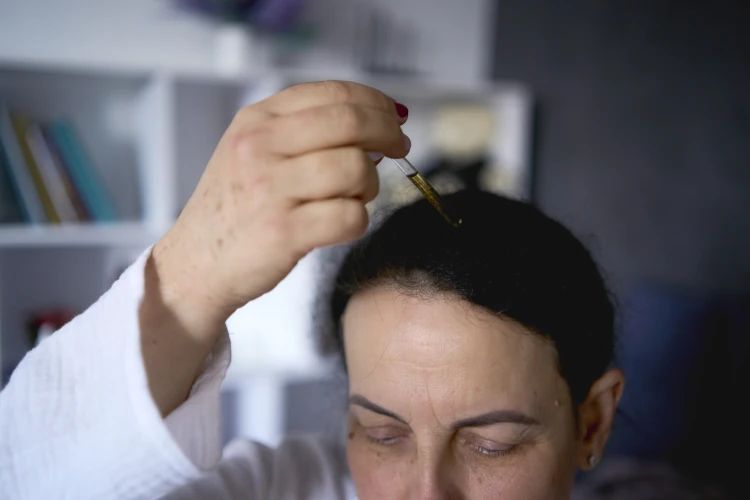
What Medications Cause Hair Loss in Females?
Your prescription medications might be the hidden culprit behind your thinning hair. Female hair loss can sometimes be linked to certain medications taken to treat various health conditions. While genetics and hormones often cause thinning hair, prescription drugs represent a significant but frequently overlooked trigger.
Many factors can contribute to hair thinning throughout your life. However, hair loss due to medication is an important cause to consider when you notice changes in your hair. Identifying medication as a potential factor helps you to have more complete conversations with your healthcare provider about your symptoms.
How Medications Can Trigger Hair Loss
Medications can disrupt your normal hair growth cycle, leading to noticeable thinning or shedding through two distinct mechanisms. The first type, telogen effluvium, pushes hair follicles into their resting phase prematurely, creating increased shedding as your hair cycle becomes disrupted.
The second type, anagen effluvium, attacks actively growing hair follicles directly. This form often results in more dramatic hair loss since it targets hair during its active growth phase. Both types interfere with your hair’s natural development process.
Your hair naturally cycles through growth, rest, and shedding phases as part of its regular pattern. When medications interfere with this process, you may notice more hair loss than usual. The disruption to your hair growth cycle manifests as increased shedding or visible thinning, depending on which phase gets affected.
Common Medications That Cause Hair Loss
Several categories of medications frequently cause hair loss in women. Each one impacts hair growth differently, making it essential to recognize which medications pose the most significant risk.
List of Medications Most Commonly Implicated in Hair Loss
- Chemotherapy agents (e.g., doxorubicin, cyclophosphamide)
- Retinoids (e.g., isotretinoin)
- Beta-blockers (e.g., propranolol)
- Antithyroid drugs (e.g., carbimazole)
- Anticonvulsants (e.g., valproate)
The timing and severity of hair loss vary depending on the specific medication and your individual response. Recognizing these common categories helps you monitor your hair when starting new treatments.
Other Factors That Can Compound Hair Loss From Medications
Pre-existing conditions, stress, hormonal imbalances, and nutrient deficiencies can worsen hair loss when taking medications that affect hair growth. Your body’s ability to maintain healthy hair depends on multiple factors functioning properly. When medications disrupt this balance, existing issues can amplify the problem significantly.
Hormonal conditions like polycystic ovary syndrome (PCOS) create additional challenges for your hair follicles through elevated androgen levels. Illnesses causing hair loss in women may make you more susceptible to medication-related hair loss.
For instance, trichotillomania affects more females than males, especially in adulthood, with female-to-male ratios reported between 4:1 and 7:1 depending on age and diagnostic criteria. Women with these conditions should monitor their hair closely when starting new treatments.
Stress from dealing with health issues requiring medication can independently trigger hair loss through telogen effluvium. Birth control changes can further complicate hair loss patterns, especially if you have a family history of female pattern baldness. These overlapping factors create compounding effects that make medication-induced hair loss more severe than it would be otherwise.
Treatment Options for Hair Regrowth

Topical treatments like minoxidil offer the first line of defense against medication-related hair loss by stimulating follicles and improving scalp blood flow. These over-the-counter solutions work most effectively when you start them early in the hair loss process. Your best results come from consistent daily application over several months.
Platelet-rich plasma (PRP) therapy harnesses your body’s natural healing factors to encourage hair regrowth. This treatment involves drawing your blood, concentrating the growth-promoting platelets, and injecting them into thinning areas of your scalp. PRP treatments may not be covered by your insurance because the treatment is not approved by the FDA. There aren’t many insurance plans that reimburse these treatments. Check with your insurance to find out more.
Advanced hair loss may require modern hair transplant techniques, like direct hair implantation (DHI) and NEO follicular unit extraction (NEO FUE), which permanently relocate healthy follicles from donor areas to thinning regions. These surgical procedures offer lasting solutions when other treatments haven’t provided sufficient improvement. Before-and-after patient transformations demonstrate the dramatic results possible with different graft counts and techniques.
Hair restoration costs vary widely based on your treatment needs, chosen method, and geographic location. Discussing your budget constraints and aesthetic goals with qualified specialists helps you select the most appropriate approach.
Managing and Preventing Hair Loss From Medications
Catching medication-induced hair loss early maximizes your treatment options and minimizes long-term damage. Hair thinning often develops gradually over weeks or months, making it easy to overlook until the loss becomes obvious. Document unusual shedding, texture shifts, or thinning patterns when you start new medications to help your healthcare provider identify potential triggers quickly.
Your doctor or pharmacist can evaluate safer alternatives without compromising your health treatment. They may suggest different medications for your condition that don’t affect hair growth or adjust dosages to reduce unwanted side effects. Never stop prescribed medications without professional guidance, as this could jeopardize treatment for severe health conditions.
Monthly monitoring helps you spot hair loss when interventions work most effectively. Take photos of your hairline and crown to track subtle changes that might go unnoticed day-to-day. Keep a simple log noting new medication start dates, increased hair shedding, and any symptoms that coincide with thinning.
Your healthcare team guides you toward restoration options that won’t interfere with current treatments. Some hair growth therapies interact with medications or underlying health conditions, making professional oversight imperative. Working with qualified providers ensures you address both primary health needs and cosmetic concerns without compromising your overall care.


